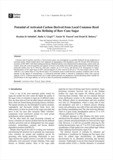

PARTNER
검증된 파트너 제휴사 자료
Potential of Activated Carbon Derived from Local Common Reed in the Refining of Raw Cane Sugar
방대한 850만건의 자료 중 주제별로 만들수 있는 최적의 산출물을 해피 캠퍼스에서 체험 하세요 전문가의 지식과 인사이트를 활용하여 쉽고 폭넓게 이해하고 적용할수 있는 기회를 놓치지 마세요
9 페이지
최초등록일 2015.03.24
최종저작일
2010.01

-
 * 본 문서는 배포용으로 복사 및 편집이 불가합니다.
* 본 문서는 배포용으로 복사 및 편집이 불가합니다.
미리보기
서지정보
· 발행기관 : 한국탄소학회
· 수록지 정보 : Carbon Letters / 11권 / 3호
· 저자명 : Ibrahim D-Abdullah, Badie S.Girgis, 2, Yassin M.Tmerek, Elsaid H
목차
1. Introduction
2. Experimental
3. Results and Discussion
4. Conclusions
References초록
Common reed (Fragmites australis), a local invasive grass, was investigated as a possible feedstock for the production of
activated carbon. Dried crushed stems were subjected to impregnation with phosphoric acid (30, 40 and 50%) followed by
pyrolysis at 400~500oC with final washing and drying. Obtained carbons were characterized by determining: carbon yield, ash
content, slurry pH, textural properties and capacity to remove color bodies from factory-grade sugar liquor. Produced carbons
possessed surface area up to 700 m2/g, total pore volumes up to 0.37 cm3/g, and proved to be microporous in nature.
Decolorization of hot sugar liquor at 80oC showed degrees of color removal of 60 up to 77% from initial color of 1100~
1300 ICU, at a carbon dose of 1.0 g/100 ml liquor. No correlation seems to hold between synthesis conditions and % R but
depends on the degree of microporosity. A commercial activated carbon N showed a comparative better color removal
capacity of 91%. Common reed proved to be a viable carbon precursor for production of good adsorbing carbon suitable for
decolorization in the sugar industry, as well as in other environmental remediation processes.영어초록
Common reed (Fragmites australis), a local invasive grass, was investigated as a possible feedstock for the production ofactivated carbon. Dried crushed stems were subjected to impregnation with phosphoric acid (30, 40 and 50%) followed bypyrolysis at 400~500oC with final washing and drying. Obtained carbons were characterized by determining: carbon yield, ashcontent, slurry pH, textural properties and capacity to remove color bodies from factory-grade sugar liquor. Produced carbonspossessed surface area up to 700 m2/g, total pore volumes up to 0.37 cm3/g, and proved to be microporous in nature.Decolorization of hot sugar liquor at 80oC showed degrees of color removal of 60 up to 77% from initial color of 1100~1300 ICU, at a carbon dose of 1.0 g/100 ml liquor. No correlation seems to hold between synthesis conditions and % R butdepends on the degree of microporosity. A commercial activated carbon N showed a comparative better color removalcapacity of 91%. Common reed proved to be a viable carbon precursor for production of good adsorbing carbon suitable fordecolorization in the sugar industry, as well as in other environmental remediation processes.참고자료
· 없음태그
-
자료후기
-
자주묻는질문의 답변을 확인해 주세요

꼭 알아주세요
-
본 학술논문은 (주)학지사와 각 학회간에 저작권계약이 체결된 것으로 AgentSoft가 제공 하고 있습니다.
본 저작물을 불법적으로 이용시는 법적인 제재가 가해질 수 있습니다. -
해피캠퍼스는 구매자와 판매자 모두가 만족하는 서비스가 되도록 노력하고 있으며, 아래의 4가지 자료환불 조건을 꼭 확인해주시기 바랍니다.
파일오류 중복자료 저작권 없음 설명과 실제 내용 불일치 파일의 다운로드가 제대로 되지 않거나 파일형식에 맞는 프로그램으로 정상 작동하지 않는 경우 다른 자료와 70% 이상 내용이 일치하는 경우 (중복임을 확인할 수 있는 근거 필요함) 인터넷의 다른 사이트, 연구기관, 학교, 서적 등의 자료를 도용한 경우 자료의 설명과 실제 자료의 내용이 일치하지 않는 경우
“Carbon Letters”의 다른 논문도 확인해 보세요!
-
Present Status and Applications of Carbon Fibers-reinforced Composites.. 8 페이지
-
Utilization of Cotton Stalks-Biomass Waste in the Production of Carbon.. 11 페이지
Four activated carbons were produced by two-stage process as followings; semi-carbonization of indigenous biomass waste, i.e. cotton stalks, followed by chemical activation with KOH under various act.. -
Tyrosinase-Immobilized Biosensor Based on Ionic Property-Modified MWNT.. 8 페이지
Two-types of ionically modified multi-walled carbon nanotube (MWNTs) based sensors were developed by radiationinduced graft polymerization using vinyl monomers such as 3-(butyl imidazol)-2-(hydroxyl).. -
Electro-responsive Transdermal Drug Release of MWCNT/PVA Nanocomposite.. 5 페이지
Multi-walled carbon nanotube (MWCNT)/poly(vinyl alcohol) (PVA) nanocomposite hydrogels were prepared by freezingthawing method for the electro-responsive transdermal drug delivery. MWCNTs were used a.. -
Adsorption of Dyes Reactive Blue 221, N Blue RGB and Acid Blue MTR on .. 5 페이지
Removal of dyes Reactive Blue 221, N Blue RGB and Acid Blue MTR using two different samples of activated carbon by static batch method was studied. Experimental data on optical density of solutions a..
찾으시던 자료가 아닌가요?
지금 보는 자료와 연관되어 있어요!
문서 초안을 생성해주는 EasyAI



